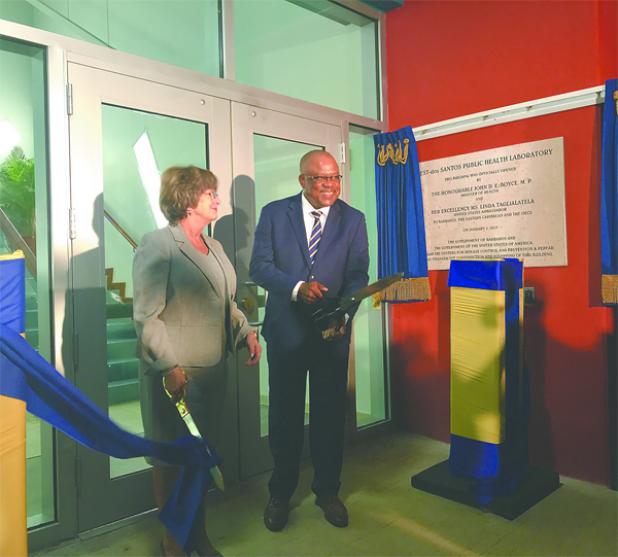
PANCAP congratulates the Government of Barbados on the opening of new public health laboratoryPANCAP Director deems the achievement a significant milestone.
Image: Barbados’ Minister of Health, John Boyce with Her Excellency Linda Taglialatela, United States Ambassador to Barbados, the Eastern Caribbean and the OECS, cutting the ribbon to officially declare the Best-dos Santos Public Health Laboratory open.
The Pan Caribbean Partnership Against HIV and AIDS (PANCAP) congratulates the Government of Barbados on the opening of the Best-dos Santos Public Health Laboratory. Director of PANCAP, Mr Dereck Springer deemed the achievement “a significant milestone and a positive step for health care in Barbados”.
Minister of Health, John Boyce, stated: “the opening of the Best-dos Santos Public Health Laboratory marks a new milestone in the public health development of Barbados”.
This comment was made by the Minister during the opening and renaming ceremony of the amalgamated public health laboratory, which was held on the grounds of the new laboratory on Friday, January 5, 2018. The new public health laboratory is an amalgamation of the Public Health Laboratory, the Ladymeade Reference Unit and the Leptospira Laboratory.
“This ceremony represents a significant milestone for us here in Barbados and celebrates the tangible beginning of a new phase in public health,” stated the Minister.
“It is indeed exciting to be a part of this opening ceremony for this new facility, which has the capacity to act as a Reference Laboratory for Barbados and the Caribbean.”
Dr Kenneth George, Acting Chief Medical Officer, expressed that the opening ceremony served also as a celebration that signified the renewal and expansion of their capacity in primary health care in Barbados, which they would not have reached without the tenacity and foresight of dedicated teams, both local and international.
“The journey of public health in Barbados has been punctuated by many success stories. From the elimination of measles to the universal acceptable levels of sanitation, to the universal access to primary healthcare, to the procurement of safe and efficacious pharmaceuticals, to the development of our national response to non-communicable diseases and, more recently our continued collective responses to the epidemics of influenza, Ebola, Chikungunya and Zika,” he said.
“This journey could not have been achieved by the Government of Barbados on its own, but through technical support, expertise and financing given by many regional, international and multilateral partners including UWI, the Caribbean Public Health Agency, WHO, PAHO, the Centres for Disease Control and Prevention and of course, the Government of the United States of America”.
He strongly expressed that it was his belief that public health represented the building of policies and programmes to strengthen the health and wellness of our population through drawing on the attributes of information sharing, strategic planning, quality assurance and monitoring and evaluation.
Following the opening ceremony, Minister Boyce, Dr. George and other officials, such as Her Excellency Linda Taglialatela, United States Ambassador to Barbados, the Eastern Caribbean and the OECS; and Laura Griesmer, Deputy Chief of Mission at the embassy of the United States of America, were treated to a tour of the new facilities.
WHAT IS PANCAP?
PANCAP is a Caribbean regional partnership of governments, regional civil society organisations, regional institutions and organisations, bilateral and multilateral agencies and contributing donor partners established on 14 February 2001. PANCAP provides a structured and unified approach to the Caribbean’s response to the HIV epidemic, and coordinates the response through the Caribbean Regional Strategic Framework on HIV and AIDS to maximise efficient use of resources and increase impact, mobilise resources and build the capacity of partners.
What are the Global AIDS Strategy 2021–2026 targets and commitments?
If targets and commitments in the strategy are achieved:
- The number of people who newly acquire HIV will decrease from 1.7 million in 2019 to less than 370 000 by 2025
- The number of people dying from AIDS-related illnesses will decrease from 690 000 in 2019 to less than 250 000 in 2025.
- The goal of eliminating new HIV infections among children will see the number of new HIV infections drop from 150,000 in 2019 to less than 22,000 in 2025.
What are the 95-95-95 Targets for ending AIDS?
- 95% of People Living with HIV know their HIV status;
- 95% of people who know their status on treatment; and
- 95% of people on treatment with suppressed viral loads.
HELPFUL LINKS:
Global AIDS Strategy 2021–2026, End Inequalities, End AIDS
https://pancap.org/pancap-documents/global-aids-strategy-2021-2026-end-inequalities-end-aids/
Caribbean Regional Strategic Framework on HIV and AIDS (CRSF) 2019-2025
https://pancap.org/pancap-documents/caribbean-regional-strategic-framework-2019-2025/
